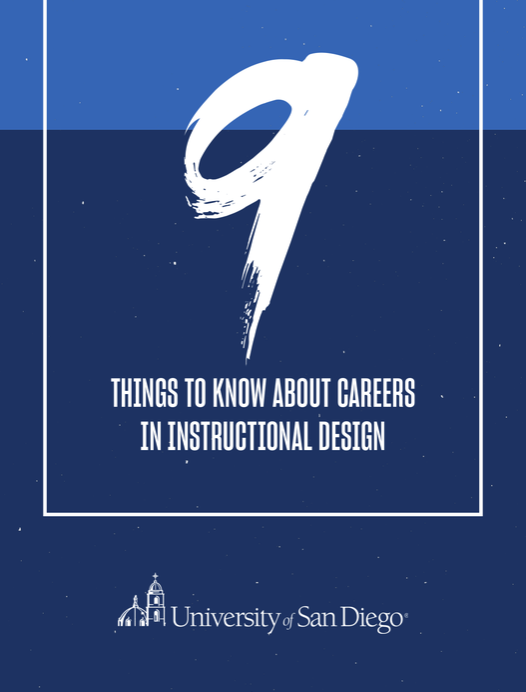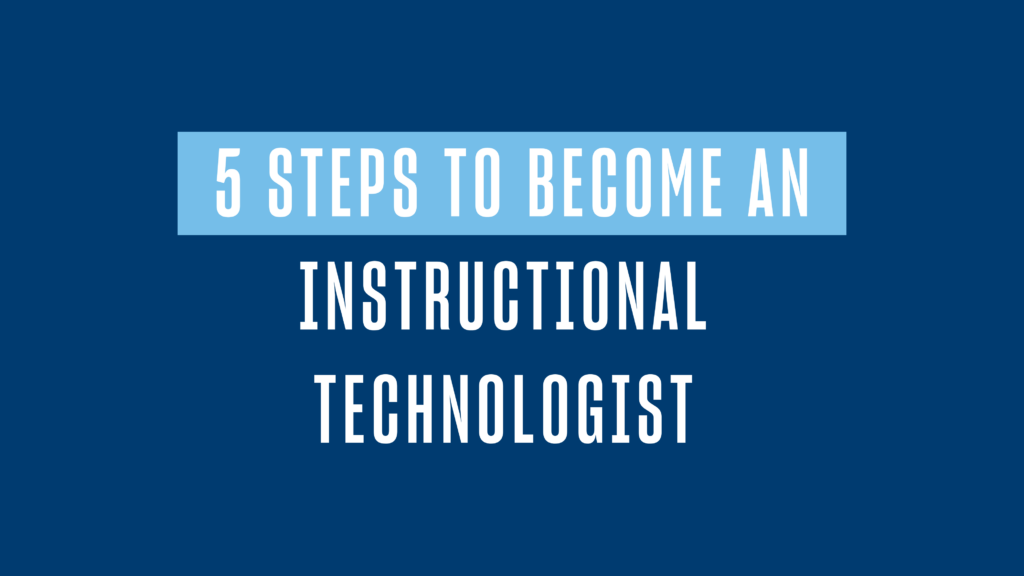As training and education experiences are increasingly digital and remote, many employers are looking for skilled instructional designers (IDs). This fast-growing career features good-paying jobs across a wide variety of industries such as education, government, business, manufacturing and more. However, while there is much interest among curious, creative professionals seeking their next opportunity, there is also some uncertainty about how to become an instructional designer.
Research by EdSurge indicates that some 87% of instructional designers have earned a master’s degree. While earning your master’s may be the best pathway for those serious about launching or advancing a career in learning design, there are other steps you can take to expand your knowledge of the field and position yourself for success.
What Is an Instructional Designer?
The educational landscape is constantly evolving, with new “best practices” and innovations emerging all the time. Instructional designers play a crucial role in ushering in and supporting these innovations, ensuring that learning experiences are as effective as possible for learners of all ages. The instructional designer’s role includes determining learning objectives, developing curricula, course content and training resources and integrating technology to enhance the teaching and learning experience.
Instructional Designer Skills
As part of their day-to-day, instructional designers collaborate, use a variety of different technologies, speak with subject matter experts and design and implement learning processes and methods. To successfully navigate this list of job responsibilities, it’s important to have the following skills:
- Interpersonal
- Technical
- Writing
- Creative
- Critical thinking
- Project management
- Design (both visual and user experience are helpful)
Why Become an Instructional Designer?
In addition to the role being in high demand, there are several reasons why becoming an instructional designer is a good career move.
- It gives you a chance to use your strengths. Instructional designers are continuously learning about new technologies, subjects and industries (depending on where they work). Writing, working closely with others and project management are also important parts of the job. If these job functions align with your interests, then a career as an instructional designer could be for you.
- You can earn a competitive salary. What you’ll make as an instructional designer will depend on factors such as where you live and work, but on average, U.S.-based IDs earn $70,602 per year — with a maximum reported salary of $109,398.
- There are opportunities to work almost anywhere. Educational institutions, corporations, nonprofit organizations and government institutions all need full-time IDs in their learning and development departments. If in-house employment isn’t something you’re looking for, additional avenues include working for an eLearning vendor or as a contractor or freelancer.
[RELATED RESOURCE] Wondering which career path fits you best? Explore your options in instructional design.
How to Become an Instructional Designer
There are six core steps that the learning design experts at the University of San Diego recommend taking on your journey to becoming an instructional designer.
1. Learn Instructional Design Theory & Skills
Essential theories, principles and frameworks are integral to instructional design, as is experience using the leading technological tools. The needed technical skills typically include software such as Articulate Storyline 360, Adobe Photoshop and familiarity with graphic design, HTML5 and learning management systems (LMS).
2. Network
Growing your professional network is a highly recommended strategy for exploring any area of interest while also developing contacts whose knowledge and connections may prove helpful as you work toward your goals. Online events, conferences and social media platforms like Twitter and the Instructional Design Forum on LinkedIn are also helpful.
Fortunately, the field of instructional design features an engaged and supportive online community of industry professionals who are eager to share information and ideas. In addition to Connie Malamed, The eLearning Coach, other helpful online resources include Dr. Luke Hobson’s blog, the E-Learning Heroes, and Instructional Design Central.
3. Create a Strong Online Portfolio
Your Instructional Design Portfolio should represent the best of what you know and can do in the field of instructional/learning design. There are many sources of information about why and how to build your portfolio. The Association for Talent Development, a professional organization of learning and development professionals, offers 10 key tips for Developing Your Portfolio as an Innovative Instructional Designer.
Award-winning eLearning designer Tim Slade offers detailed strategies for building your eLearning portfolio, sharing insights learned from his extensive experience. According to a survey Slade conducted on LinkedIn, 90% of hiring managers reported that it’s either “important” or “very important” to see a candidate’s portfolio during the hiring process.
Here’s what he recommends when creating your first portfolio:
- Taking inspiration from the portfolios of established instructional designers
- Identifying which of your skills you want to highlight, and focusing on them
- Creating and including sample projects if you don’t have any real-world examples to feature
- Building a website for your portfolio
- Showcasing your work on your website, dedicating space for each sample
4. Get Experience
Finding ways to get practical experience can be challenging if you’re just getting started on the path toward becoming an instructional designer. Learning the tools and theories and then using your skills and knowledge to create sample projects is a great way to develop and display your skills.
There may be opportunities at your current job to gain experience in creating training materials (for example, using PowerPoint and other tools to put together work-related presentations). Another great source of inspiration are the instructional design challenges posted on the Go Design Something website. Site creator K. Anthony says, “If you’ve wanted to get started on a project but you couldn’t figure out how to get started, this is the site to get you going.”
5. Earn a Master’s Degree
In a field where a high percentage of practitioners have a master’s degree (87%, according to EdSurge), earning an advanced degree is a proven way to accomplish all of the actions discussed above while learning everything about the profession from experienced instructional designers.
Today, there is a growing number of master’s degree programs training the next generation of learning designers and ID industry leaders. For example, the University of San Diego offers an innovative, online Master of Science in Learning Design and Technology degree program that is designed to meet the needs of aspiring learning designers.
The USD Learning Design and Technology master’s degree program is designed to be a career-building educational experience. Its comprehensive curriculum is intended for those who want to become instructional designers, as well as established professionals looking to expand their skills (including project management and ID leadership capabilities), advance in the field or explore related opportunities.
Delivered in a fully online format ideal for working professionals, this program places a strong emphasis on cultivating successful instructional design practitioners. Throughout the MS-LDT program, students work to build a peer-evaluated online portfolio that showcases instructional design skills and projects and can be used to wow prospective employers when applying for jobs or promotions.
[FREE GUIDE] Ready to join a high-demand field? See how instructional design offers exciting career growth.
6. Ace the Interview
When preparing for job interviews, get all of your professional materials organized and prepare to answer questions that best illustrate your knowledge and experience. Some good interview prep steps include:
- Update your portfolio
- Have a good story to tell
- Identify what excites you about instructional design
- Be prepared to discuss your process, design decisions and evaluation measures
- Choose particular challenges to discuss and your strategies for working around roadblocks
- Prepare situational answers if prompted with hypothetical scenarios
Armed with demonstrable experience, a robust portfolio, the right skill set and a master’s degree from a reputable university, you will surely be able to make the jump into the exciting field of instructional design.
See overview: University of San Diego – Master of Science in Learning Design and Technology
![How to Become an Instructional Designer [6-Step Guide]](https://onlinedegrees.sandiego.edu/wp-content/uploads/2021/08/ldt_blog_becomeanid.png)

![Preview image of What is Instructional Design? [5 Examples + Overview]](https://onlinedegrees.sandiego.edu/wp-content/uploads/2021/08/ldt_blog_whatisid-1024x576.png)
![What Does an Instructional Designer Do? [Career Info & FAQs]](https://onlinedegrees.sandiego.edu/wp-content/uploads/2021/08/ldt_blog_whatdoesiddo-1024x576.png)
